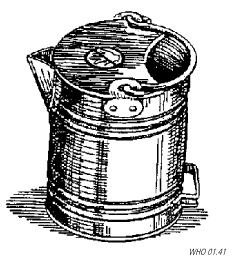In this months Bulletin
Hurricanes and pesticides
Hurricane Mitch hit Honduras on 30 October 1998, producing flooding and mud slides throughout the country and killing more than 6500 people. Balluz et al. (pp. 288295) describe a study conducted shortly after the hurricane to determine whether the flooding, during which 300400 barrels of pesticides were lost, had caused contamination of drinking-water.The study, conducted in the barrio of Istoca, Choluteca Department, an area particularly hard hit by the hurricane, involved a questionnaire survey of 155 households, as well as analysis of water and soil samples, and of blood and urine samples from adolescents.The study found little contamination of water supplies.All the soil samples, however, contained levels of organophosphate pesticides, which in some cases may be high enough to be a health concern. Metabolites of these chemicals, which are mostly cleared from the body within 24 hours, were found in urine samples from the adolescents almost a month after the hurricane, suggesting continued exposure to the pesticides whether the pesticides came from the lost barrels or from other sources. Study participants in the area reported a number of symptoms, including headache, tiredness, skin rash, abdominal pain, chills, nausea and decreased appetite, that might have been linked to this exposure. Most strikingly, though, the adolescents blood samples contained high concentrations of chlorinated pesticides, including DDT, DDE (dichlorodiphenyl dichloroethylene) and dieldrin. Si nce these chemicals were banned in Honduras 15 years ago they are endocrine disruptors and can cause abnormal sexual development and increased risk of cancer, particularly of the breast and prostate they are probably still being used illegally in the area.
Epilepsy, another neglected burden on the poor
With an estimated 50 million sufferers, epilepsy is the most prevalent among the severe neurological disorders.Four-fifths of cases occur in developing countries, where annual incidence rates of up to 190 per 100 000 people have been recorded, vs 50 70 per 100 000 in industrialized countries.In a review of this major public health problem, Scott et al.(pp. 344351) note that although the vast majority of epilepsy sufferers are in developing countries 90% of them receive no treatment at all. One result is that antiepilepsy stigma remains rife in these countries and patients quality of life remains well below that associated with other chronic illnesses.Obstacles to ensuring wider availability of treatment include unfavourable cultural attitudes, poverty, poor health system infrastructure and inadequate supplies of anti-epileptic drugs. Projects completed or under way in China, India, Kenya, and Malawi suggest ways of overcoming some of these obstacles.
Improving the use of antibiotics a Vietnamese success story
Overuse and misuse of antibiotics are a recipe for generating resistance to these lifesaving drugs.Chalk er (pp. 313320) describes a project conducted in the Viet Nam province of Hai Phong aimed at improving the use of antibiotics.The project involved monthly supervision of the use of all commonly used antibiotics in the 217 commune health stations of the province over a period of 6 to 24 months. Preparation of the project included a local information-education-communication campaign.Health workers were carefully briefed, and their active collaboration with and diligent adherence to the project were enouraged by the promise of free equipment for their health stations. On completion of the project, the frequency of antibiotic usage had fallen from 65% to 45% of patient encounters and the frequency with which adequate dosage was prescribed had risen from under 30% to 98% of treated patients. These positive results were maintained for 17 months after the project stopped. The author believes the strategy he describes could be applied widely throughout the developing world.
A better bucket to keep cholera at bay
Household contamination of water is known to be a cause of cholera.Les Roberts et al. (pp.280287) report a randomized trial of a relatively inexpensive solution: a bucket specially designed, with a cover and spout, to reduce the risk of bacterial contamination of water stored in the home and consequent diarrhoeal disease.The trial was carried out in 1993 in a refugee camp in southern Malawi, where an investigation of a cholera outbreak two years previously had shown well water to be safe but water stored at home to be frequently contaminated with Vibrio cholerae.The improved 20-litre bucket had, in addition to a spout, a constraining lid to prevent access of the bucket by a hand or cup.One source of contamination in the control households, the study found, was womens habit of rinsing the inside rim of their usual buckets with one hand.Use of the new bucket, randomly allocated to 200 households in the camp, was associated with a 69% reduction in faecal coliform contamination of household water and a 31% reduction in diarrhoeal disease in under-5-year-old children compared with 200 control households not given the bucket.

Family affairs
In industrialized countries, an individual with a family history of hypertension has an up to fourfold risk of becoming hypertensive, according to epidemiological research. For what they believe is the first time, van der Sande et al.show (pp. 321 328) that in Africans, family history is predictive of hypertension, but also of obesity, diabetes and stroke.The authors describe a study conducted in 5389 adults in the Gambia, West Africa, who underwent clinical examination and biochemical tests for these illnesses and were questioned about their occurrence in family members. Overall, a family history of any one of the four conditions hypertension, obesity, diabetes or stroke was associated with an increased risk of obesity and hyperlipidaemia. The authors note that in poor countries with many pressing health needs, including the emergence of cardiovascular disease, a look at the first-degree family history can be helpful in planning interventions aimed at high-risk groups.In societies with a very close-knit family structure, lifestyle modification to prevent, for example, cardiovascular disease is virtually impossible without the support of the family.
